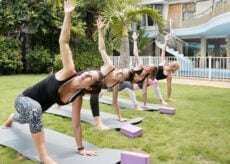How to Do a Squat Correctly (for Beginners)

There are several exercises that may seem a bit daunting at first, especially if you’re new to this whole exercise thing, and one of the biggies is probably squats. While it may not seem like it should be so difficult at the outset, once you get started, it becomes more of a question of how to do a squat correctly.
What is a Squat?
It might be easiest to move into learning squats and squat modifications if we start by describing what a “normal” bodyweight squat entails. A normal squat will have you start by standing with your feet slightly wider than hip-width apart with your feet flat on the ground.
Believe it or not, squatting is about more than just bending your knees! The movement itself is a combination of both flexing at the hips (like you’re sitting down) and bending at the knees.
And again, for a regular run-of-the-mill squat, your feet will be flat and fully connected to the ground.
Next, you’ll push your hips back (as if you were going to sit down) while simultaneously bending at the knees. In other words, your torso will lean forward a little as your hips move backward and your knees naturally bend to allow for the downward drop of your hips. This will allow your hips to drop down between your knees toward the ground. Go as low as you’re comfortable going.
How to Do a Squat for Beginners
Probably the easiest way to get started on how to do a squat (for beginners) is to begin with some modifications. Don’t get overwhelmed by what you can’t do. Start with what you can do. You may need a little external stabilization to get the movement ingrained. If you do need more stability and support, you can move to using the assistance of a wall, a chair, or a pole.
Squat Modifications
1. Start with a smaller range of motion.
Maybe you can start with just a little bit of movement. If you don’t have a large range of motion at first, that’s okay. Just try to begin by standing and then squat down as far as you can. It may only be a quarter of a squat at first, but that’s okay. Just keep practicing, going down a little deeper each day, until you can squat down to the point where your thighs are parallel to the ground (or, if you’re doing a bodyweight squat, even past parallel).
Once you learn to improve your range of motion, and you get more stable, you’ll improve your squat tremendously. Also, once you can increase your stability, you’ll have better mobility as well. With practice, you’ll get stronger, and if you combine your newfound strength with external stability and mobility, you’ll be able to graduate to a regular squat at some point.
2. Chair-Assisted Squats
Put a chair in front of you and stand with your feet a little wider than hip-width apart. The wider the stance and the higher the chair, the easier the squat. Place your hands on the back of the chair and lower yourself into the squat position, using the chair back for support.
3. Pole-Assisted Squats
In a similar fashion to chair-assisted squats, place a pole in front of you and grasp it with both hands. Again, perform a squatting movement using the pole for added support. The further out you reach your arms, the further down you’ll be able to squat.
4. Wall-Assisted Squats
Face a wall and place both hands a little wider than shoulder-width apart in front of you on the wall. Glide your hands down the wall as you perform the squatting movement, using the wall for as much or as little support as you require.
Eventually, you should be able to graduate to using just one hand on the chair, one hand on the pole, or one hand on the wall.
5. Lifted-Heel Squats
If your range of motion is limited due to tightness in the calves or ankles, you can also experiment with lifting your heels before squatting. Try a 2 x 4 or a few weight plates under your heels to help compensate for the lack of range of motion as you work on improving mobility.
Some Additional Squatting Tips
- Spend more time in the deep squat position to get your hips used to the range of motion. The more you practice hanging out in the deep squat position, the more familiar and comfortable it will become. You can even use your elbows to push your knees further apart and hold that stretch for 15 seconds, working your way up to two minutes.
- Practicing your deep squats on the regular will help you achieve radical changes in your mobility across the board and can even help alleviate lower back pain.
- Work away from four points of stability (i.e., two feet on the ground and two hands on the chair) to three points of stability (one hand on the chair and two feet on the ground) until you are down to two points of stability (feet only).






